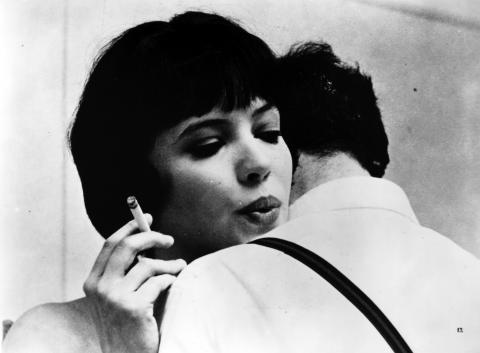The Stylistic Experimentation of VIVRE SA VIE

VIVRE SA VIE
These notes on Jean-Luc Godard's Vivre sa vie (1962) were written by Dillon Mitchell, Ph.D candidate in the Department of Communication Arts at UW Madison. Vivre sa vie was originally scheduled to screen as a tribute to the late Anna Karina (1940-2019) on Sunday, March 15 at 2 p.m. at the Chazen Museum of Art. In compliance with UW Madison’s policies enacted to slow the spread of COVID-19 this screening has been canceled along with all previously announced UW Cinematheque screenings through April 12. The Cinematheque Programming staff is currently investigating the possibility of re-scheduling some of these screenings on future Cinematheque calendars.
By Dillon Mitchell
Few films have challenged the language of cinematic narrative to the point that they necessitate new tools for understanding: Vivre sa vie is one of them. The third feature from French auteur Jean-Luc Godard, Vivre sa vie was released only two years after Godard’s now-canonized breakout hit, Breathless (1960). In many ways, it has become a more accurate signal of things to come for the filmmaker. Dense and challenging, Vivre sa vie presages the gleeful rejection of filmmaking conventions that will come to define much of Godard’s later work.
Despite its roots in the art cinema movement of the French New Wave, film scholar David Bordwell argues that Vivre sa vie – and Godard’s work at large – defies easy categorization as art cinema. Though commonly thought of as lacking universal governing principles, Bordwell identifies commonalities across art cinema as it positions itself against classical cinema: characteristics like a denial of causal relationships and narrative finality, overt commentary on the construction of narration, and a focus on filmic realism are examples of art cinema norms that he details. Gordard’s work is different, then, because it employs and ignores norms as it sees fit, sometimes changing its relationship to them on a scene-to-scene basis.
The defining feature of Vivre sa vie is its organization into 12 “tableaus,” chapters in the life of the central character Nana (played by late, iconic French actress Anna Karina, who was married to Godard at the time of filming and acted in eight of his films during the 1960s). This self-conscious structuring device offers audiences entry points into a narrative that is otherwise unconcerned with their comprehension of events. Bordwell writes that “the narration [of a Godard film] can be completely uncommunicative, leaving many permanent gaps,” citing the indeterminate time that passes between the tableaus of Vivre sa Vie as an example.
Style differs across the tableaus, each one distinct, marginally or substantially, from the others. Techniques may be present across multiple sections, but their execution and effect vary: shot-reverse shot sequences, for example, become an arena for Godard’s stylistic experimentation. From the very beginning of the first tableau, he circumvents traditional logic for filming these scenes by framing his subjects from behind – instead of seeing their facial expressions for an emotionally charged exchange, we’re denied access, made to grasp onto Nana’s out-of-focus mirror reflection in the background as a kind of anchor. Throughout, Godard finds new ways to obscure conversations and frustrate expectation. Another device that extends across tableaus is Nana’s point-of-view. The brief point-of-view shots shown in the fifth tableau are markedly different from the floating camera movement of Nana’s perspective in the ninth tableau’s mesmerizing dance sequence. Despite their shared technique, both moments capture Nana’s subjectivity with different means to different ends.
It is Nana, whose struggles for agency punctuate the tableaus, that bind this obtuse, fragmented narrative and stylistic system. Vivre sa vie opens with a quote from French philosopher Michel de Montaigne: “Il faut se préter aux autres et se donner a soi-même,” roughly translated in the English subtitles to, “Lend yourself to others, but give yourself to yourself.” Across the 12 tableaus, Nana’s increasing inability to balance that interpersonal dynamic in patriarchal society defines her trajectory; the film’s style, despite its lack of internal unity, frequently coheres around this idea.
Some of the film’s most affecting moments come when the form serves to highlight Karina’s performance. An early tableau features a short interrogation of Nana by a police office. Godard shoots her in medium close-up and close-up shots, her face oriented directly toward the camera in a straight angle. As she recounts her story, however, her eyes are fixed on the ground, her gaze only rising to meet the camera sporadically. In those moments, Nana’s façade threatens to break: Karina’s eyes run wild while her face remains still, and Godard never pulls away to show the officer’s reaction while she speaks – only to ask her more questions when she is silent. The tableau ends when Nana eventually doesn’t have an answer for the question posed. She looks off-screen, desperate for an escape that the claustrophobic framing does not offer.
A lack of formal consistency across the film does not necessarily amount to meaningless style. Though Godard may be popularly known for his love of “style for style’s sake,” the range to be found in Vivre sa vie does make for powerful moments united around Nana. Vivre sa vie is a film that rewards repeat viewing, not because it is meant to be solved, but because it offers so many details to pore over and appreciate each time. There are moments of familiarity, elements recognizable from both the art cinema and classical cinema traditions, but it presents an experience wholly unlike another single film.
